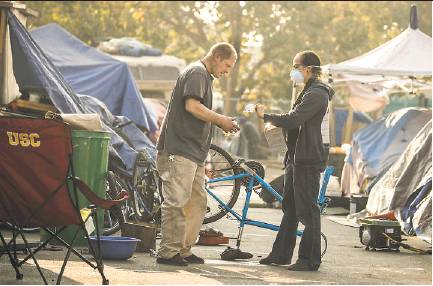Oakland stunned by 47% rise in homeless count
By Sarah RavaniOakland’s homeless population rose 47% between 2017 and 2019, one of the biggest twoyear increases of any California city, according to a one-night street count released Monday by county officials.
The jump means Oakland’s per capita homeless rate now surpasses the same figure in San Francisco and Berkeley, at a time when cities around the Bay Area and the country are struggling with a crisis driven by drug addiction, mental illness and a lack of housing.
In the count taken in January using federal guidelines, Oakland had 861 sheltered people and 3,210 unsheltered people, bringing the estimated number of homeless people to 4,071. In 2017, Oakland had 859 sheltered people and 1,902 unsheltered residents, a total of 2,761.
The spike, which shocked many at City Hall, comes despite efforts by the city to tackle the homelessness problem, including the creation of community cabins and the opening of a safe RV parking site.
“Of course, it is disappointing ... that we’ve had the highest increase, at least in the Bay Area,” said Oakland Mayor Libby Schaaf. “It shows that we need to do more; we need to do things differently and we need to act with a sense of urgency that is greater than anything we’ve seen in the past.”
Oakland’s homelessness rate is now 940 per 100,000 population, slightly higher than San Francisco, at 906, and Berkeley, at 898.
The city’s homeless population accounts for nearly half of Alameda County’s total, according to the new figures shared at a meeting on homelessness with mayors from 14 cities in the county and the county’s Board of Supervisors. The count showed that the number of homeless people countywide rose 43%, from 5,629 in 2017 to 8,022 in 2019.
According to the data, 34% of homeless people in Alameda County live in tents and 23% live in vehicles. African Americans made up 50% of the homeless population, despite comprising just 11% of the county’s total population.
“The biggest growth area in homelessness are actually people who still have a car or an RV and are choosing to live in it because they can’t afford housing in Alameda County.” said Elaine de Coligny, executive director of EveryOne Counts, the organization that conducts the homeless census across California.
Last month, the city opened its first safe RV parking site in East Oakland. The space, near the Coliseum BART Station, has security, a full-time site manager, portable toilets and wash stations with mobile shower trucks that will begin making weekly visits soon. Several weeks ago, the city revealed plans to open a safe RV parking site for vehicle dwellers in front of Home Depot’s store in the Fruitvale neighborhood in coming months.
Earlier this month, the city opened its fifth community cabin site near 35th and Magnolia streets. Residents of a nearby encampment will be moved into the site before the encampment is shut down.
In spite of the initiatives, many advocates for homeless people said the city was not doing enough. Some said the community cabin sites and RV parking sites don’t offer enough space for the number of homeless people in the city. Instead, they urged the city to think of solutions that provide affordable housing to everyone who needs it.
“We have a one-size-fits-all model, and it’s not working, and it’s contributing to the homelessness crisis,” said Margaretta Lin, the executive director of Just Cities/the Dellums Institute. “I think what troubles me is we are not devoting enough of our new affordable housing stock to be affordable to people who are currently unhoused, or the working poor.”
Alameda County Supervisor Nate Miley agreed that the county and cities have a lot of work to do to eradicate homelessness by their set goal of 2024.
“It’s clearly a short-term solution to have the safe car parking, to try to have the cabin communities, to try to support sanctioned encampments,” he said.
Miley said he was committed to building affordable housing for all income levels at a faster pace. Monday’s meeting was the first time that mayors from all of the county’s cities and the Board of Supervisors convened specifically to address the homelessness epidemic, a gathering that Miley said was a good first step. He said the group was looking to begin meeting quarterly to evaluate progress on the issue.
Elsewhere in the county, Berkeley reported a 13% increase since 2017 with 1,108 homeless people — 295 who were sheltered, 813 who were unsheltered — compared with 972 people two years ago. San Leandro’s homeless population grew from 109 in 2017 to 418 this year.
Across Alameda County, the Point-In-Time count showed that 57% of homeless people have lived in the county for more than 10 years, while 12% have lived in the county for less than a year. Sixty-three percent of people have been homeless for more than a year.
“We need to get people off the street,” Schaaf said. “And I hope that that is what the renewed focus is on.”
Sarah Ravani is a San Francisco Chronicle staff writer. Email: sravani@sfchronicle.com Twitter: @SarRavani

